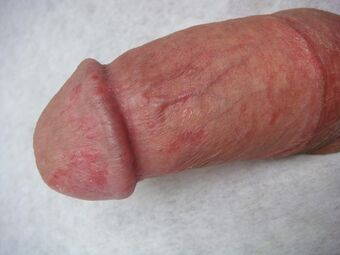Medicine:Balanitis
| Balanitis | |
|---|---|
 | |
| Inflammation of the glans penis and the preputial mucosa of a circumcised penis (balanitis) | |
| Specialty | Urology |

Balanitis is inflammation of the glans penis.[1] When the foreskin is also affected, the proper term is balanoposthitis.[1] Balanitis on boys still in diapers must be distinguished from redness caused by ammoniacal dermatitis.[2] The word balanitis is from the Greek βάλανος balanos, literally meaning 'acorn', used because of the similarity in shape to the glans penis.[3]
Signs and symptoms
- Small red erosions on the glans (first sign)
- Redness of the foreskin
- Redness of the penis
- Other rashes on the head of the penis
- Foul smelling discharge
- Painful foreskin and penis
Complications
Recurrent bouts of balanitis may cause scarring of the preputial orifice; the reduced elasticity may lead to pathologic phimosis.[4] Further complications may include:
- Stricture of urinary meatus
- Phimosis
- Paraphimosis
Cause
Inflammation has many possible causes, including irritation by environmental substances, certain medications, physical trauma, and infection such as bacterial, viral, or fungal.[5][6] Some of these infections are sexually transmitted.
It is less common among people who are circumcised, as in many cases, a dysfunction of the foreskin is a causal or contributing factor.[1] Both not enough cleaning and too much cleaning can cause problems.[1]
Diagnosis
Diagnosis may include careful identification of the cause with the aid of a good patient history, swabs and cultures, and pathological examination of a biopsy.[5]
Types
- Zoon's balanitis, also known as Balanitis Circumscripta Plasmacellularis or plasma cell balanitis (PCB), is an idiopathic, rare, benign penile dermatosis[7] for which circumcision is often the preferred treatment.[7][8][9] Zoon's balanitis has been successfully treated with the carbon dioxide laser; [10] and more recently, Albertini and colleagues report the avoidance of circumcision and successful treatment of Zoon's balanitis with an Er:YAG laser.[11] Another study, by Retamar and colleagues, found that 40 percent of those treated with CO2 laser relapsed.[12]
- Circinate balanitis, also known as balanitis circinata, is a serpiginous annular dermatitis associated with reactive arthritis.
- Pseudoepitheliomatous keratotic and micaceous balanitis
Treatment
Initial treatment in adults often involves simply pulling back the foreskin and cleaning the penis.[1] However, some topical antibiotic and fungal ointments may be used for treatment for mild cases. Depending upon severity, hydrocortisone and other steroidal creams may be used upon consultation.
Epidemiology
Balanitis "is a common condition affecting 11% of adult men seen in urology clinics and 3% of children" in the United States; globally, balanitis "may occur in up to 3% of uncircumcised males".[13]
Other animals

In dogs, balanoposthitis is caused by a disruption in the integumentary system, such as a wound or intrusion of a foreign body. A dog with this condition behaves normally, with the exception of excessive licking at the prepuce, and a yellow green, pus-like discharge is usually present.
In sheep (rams/wethers), ulcerative enzootic balanoposthitis is caused by the Corynebacterium renale group (C. renale, C. pilosum & C. cystidis).
For the condition in bulls, caused by a virus see Bovine herpesvirus 1.
Balanoposthitis is believed to have contributed to the decline to near-extinction of Gilbert's potoroo.[14]
References
- ↑ 1.0 1.1 1.2 1.3 1.4 Edwards, SK; Bunker, CB; Ziller, F; van der Meijden, WI (August 2014). "2013 European guideline for the management of balanoposthitis.". International Journal of STD & AIDS 25 (9): 615–26. doi:10.1177/0956462414533099. PMID 24828553.
- ↑ "The management of the paediatric foreskin". Aust Fam Physician 27 (5): 381–3. 1998. PMID 9613002.
- ↑ βάλανος. Liddell, Henry George; Scott, Robert; A Greek–English Lexicon at the Perseus Project.
- ↑ Phimosis at eMedicine
- ↑ 5.0 5.1 Edwards S (1996). "Balanitis and balanoposthitis: a review". Genitourin Med 72 (3): 155–9. doi:10.1136/sti.72.3.155. PMID 8707315.
- ↑ Cleveland Clinic: Penile Disorders
- ↑ 7.0 7.1 Keogh G. Balanitis circumscripta plasmacellularis at eMedicine
- ↑ "[Zoon's balanoposthitis. A preliminary note]" (in es). Arch. Esp. Urol. 52 (1): 69–72. 1999. PMID 10101891.
- ↑ Buechner SA (2002). "Common skin disorders of the penis". BJU Int. 90 (5): 498–506. doi:10.1046/j.1464-410X.2002.02962.x. PMID 12175386.
- ↑ "The treatment of Zoon's balanitis with the carbon dioxide laser". The Journal of Dermatologic Surgery and Oncology 15 (5): 491–4. 1989. doi:10.1111/j.1524-4725.1989.tb03407.x. PMID 2497162.
- ↑ "Zoon's balanitis treated with Erbium:YAG laser ablation". Lasers Surg Med 30 (2): 123–6. 2002. doi:10.1002/lsm.10037. PMID 11870791. https://zenodo.org/record/1229277.
- ↑ "Zoon's balanitis: presentation of 15 patients, five treated with a carbon dioxide laser". Int. J. Dermatol. 42 (4): 305–7. 2003. doi:10.1046/j.1365-4362.2003.01304.x. PMID 12694501.
- ↑ Balanitis at eMedicine
- ↑ Vaughan-Higgins, Rebecca; Buller, Nicky; Friend, J. Anthony; Robertson, Ian; Monaghan, Cree L.; Fenwick, Stan; Warren, Kristin (2011). "Balanoposthitis, Dyspareunia, and Treponema in the Critically Endangered Gilbert's Potoroo (Potorous gilbertii)". Journal of Wildlife Diseases 47 (4): 1019–1025. doi:10.7589/0090-3558-47.4.1019. PMID 22102677. http://researchrepository.murdoch.edu.au/id/eprint/6136/.
Further reading
- Edwards S. (for the Clinical Effectiveness Group) National guideline on the management of balanitis. Association for Genitourinary Medicine (UK) and the Medical Society for the Study of Venereal Diseases (UK), 2001.
External links
| Classification | |
|---|---|
| External resources |
 |
